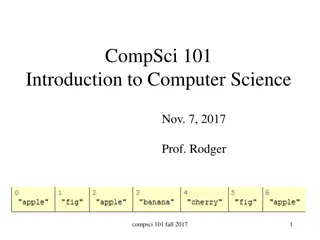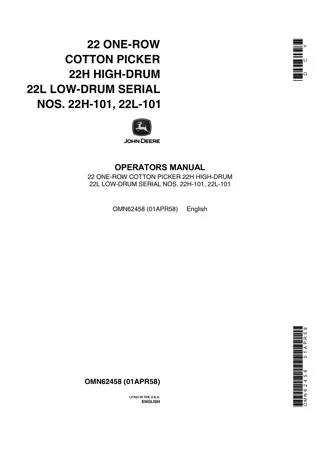CompSci 101 Introduction to Computer Science
This content delves into the world of computer science, exploring problem-solving techniques and algorithms. It covers topics such as sorting methods in Python, building dictionaries for games like Clever Hangman, and analyzing algorithms for tasks like playing card games. Additionally, it discusses scaling algorithms for handling growing problems efficiently and explores top song rankings as a problem-solving exercise. The material provides valuable insights into various facets of computer science, offering a comprehensive overview for beginners.
Download Presentation

Please find below an Image/Link to download the presentation.
The content on the website is provided AS IS for your information and personal use only. It may not be sold, licensed, or shared on other websites without obtaining consent from the author.If you encounter any issues during the download, it is possible that the publisher has removed the file from their server.
You are allowed to download the files provided on this website for personal or commercial use, subject to the condition that they are used lawfully. All files are the property of their respective owners.
The content on the website is provided AS IS for your information and personal use only. It may not be sold, licensed, or shared on other websites without obtaining consent from the author.
E N D
Presentation Transcript
CompSci 101 Introduction to Computer Science Nov. 22 , 2016 Prof. Rodger compsci101 fall2016 1
Announcements Reading and RQ due next time Assignment 7 due next Tuesday Assignment 8 and 9 out soon APT 9 out and due in a week and a half Today: Solving problems How do change how things are sorted? Other than ordering and re-ordering tuple How do Python .sort and sorted() stack up? compsci101 fall2016 2
Clever Hangman - Dictionary Builds a dictionary of categories Start with list of words of correct size Repeat User picks a letter Make dictionary of categories based on letter New list of words is largest category Category includes already matched letters List shrinks in size each time cps101 fall 2016 3
Clever Hangman Example Possible scenerio after several rounds From list of words with a the second letter. From that build a dictionary of list of words with no d and with d in different places: Choose no d , most words, 147 Only 17 words of this type Only 1 word of this type 4
Clever Hangman How to start? How to modify assignment 5? compsci101 fall2016 5
Playing go-fish, spades, or Finding right card? What helps? Issues here? Describe algorithm: First do this Then do this Substeps ok When are you done? compsci101 fall2016 6
Problem Solving with Algorithms Top 100 songs of all time, top 2 artists? Most songs in top 100 Wrong answers heavily penalized You did this in lab, you could do this with a spreadsheet What about top 1,000 songs, top 10 artists? How is this problem the same? How is this problem different compsci101 fall2016 7
Scale As the size of the problem grows The algorithm continues to work A new algorithm is needed New engineering for old algorithm Search Making Google search results work Making SoundHound search results work Making Content ID work on YouTube compsci101 fall2016 8
Python to the rescue? Top1000.py import csv, operator f = open('top1000.csv','rbU') data = {} for d in csv.reader(f,delimiter=',',quotechar='"'): artist = d[2] song = d[1] if not artist in data: data[artist] = 0 data[artist] += 1 itemlist = data.items() dds = sorted(itemlist,key=operator.itemgetter(1),reverse=True) print dds[:30] compsci101 fall2016 9
Understanding sorting API How API works for sorted() or .sort() Alternative to changing order in tuples and then changing back x = sorted([(t[1],t[0]) for t in dict.items()]) x = [(t[1],t[0]) for t in x] x = sorted(dict.items(),key=operator.itemgetter(1)) Sorted argument is key to be sorted on, specify which element of tuple. Must import library operator for this compsci101 fall2016 10
Sorting from an API/Client perspective API is Application Programming Interface, what is this for sorted(..) and .sort() in Python? Sorting algorithm is efficient, stable: part of API? sorted returns a list, doesn't change argument sorted(list,reverse=True), part of API foo.sort() modifies foo, same algorithm, API How can you change how sorting works? Change order in tuples being sorted, [(t[1],t[0]) for t in ] Alternatively: key=operator.itemgetter(1) compsci101 fall2016 11
Beyond the API, how do you sort? Beyond the API, how do you sort in practice? Leveraging the stable part of API specification? If you want to sort by number first, largest first, breaking ties alphabetically, how can you do that? Idiom: Sort by two criteria: use a two-pass sort, first is secondary criteria (e.g., break ties) [("ant",5),("bat", 4),("cat",5),("dog",4)] [("ant",5),("cat", 5),("bat",4),("dog",4)] compsci101 fall2016 12
Two-pass (or more) sorting Because sort is stable sort first on tie- breaker, then that order is fixed since stable a0 = sorted(data,key=operator.itemgetter(0)) a1 = sorted(a0,key=operator.itemgetter(2)) a2 = sorted(a1,key=operator.itemgetter(1)) data [('f', 2, 0), ('c', 2, 5), ('b', 3, 0), ('e', 1, 4), ('a', 2, 0), ('d', 2, 4)] a0 [('a', 2, 0), ('b', 3, 0), ('c', 2, 5), ('d', 2, 4), ('e', 1, 4), ('f', 2, 0)] compsci101 fall2016 13
Two-pass (or more) sorting a0 = sorted(data,key=operator.itemgetter(0)) a1 = sorted(a0,key=operator.itemgetter(2)) a2 = sorted(a1,key=operator.itemgetter(1)) a0 [('a', 2, 0), ('b', 3, 0), ('c', 2, 5), ('d', 2, 4), ('e', 1, 4), ('f', 2, 0)] a1 [('a', 2, 0), ('b', 3, 0), ('f', 2, 0), ('d', 2, 4), ('e', 1, 4), ('c', 2, 5)] a2 [('e', 1, 4), ('a', 2, 0), ('f', 2, 0), ('d', 2, 4), ('c', 2, 5), ('b', 3, 0)] compsci101 fall2016 14
Answer Questions bit.ly/101f16-1122-1 SortByFreqs APT Sort items by their frequency, then sorted in frequencies. compsci101 fall2016 15
Answer Questions bit.ly/101f16-1122-2 MedalTable APT Sort items by their frequency, then sorted in frequencies. compsci101 fall2016 16
Timingsorts.py, what sort to call? Simple to understand, hard to do fast and at-scale Scaling is what makes computer science Efficient algorithms don't matter on lists of 100 or 1000 Named algorithms in 201 and other courses bubble sort, selection sort, merge, quick, See next slide and TimingSorts.py Basics of algorithm analysis: theory and practice We can look at empirical results, would also like to be able to look at code and analyze mathemetically! How does algorithm scale? compsci101 fall2016 17
New sorting algorithms happen timsort is standard on Python as of version 2.3, Android, Java 7 According to http://en.wikipedia.org/wiki/Timsort Adaptive, stable, natural mergesort with supernatural performance What is mergesort? Fast and Stable What does this mean? Which is most important? Nothing is faster, what does that mean? Quicksort is faster, what does that mean? compsci101 fall2016 18
TimingSorts.py size create 0.026 0.045 0.058 0.082 0.101 0.118 0.168 0.156 0.184 0.212 bubble 0.127 0.537 1.126 2.174 3.521 4.617 7.504 9.074 11.611 14.502 select 0.081 0.273 0.646 1.208 1.862 3.005 4.237 6.152 8.089 9.384 timsort 0.002 0.001 0.002 0.003 0.003 0.004 0.005 0.007 0.007 0.008 1000 2000 3000 4000 5000 6000 7000 8000 9000 10000 compsci101 fall2016 19
Stable, Stability What does the search query 'stable sort' show us? Image search explained First shape, then color: for equal colors? compsci101 fall2016 20
Stable sorting: respect re-order Women before men First sort by height, then sort by gender compsci101 fall2016 21
How to import: in general and sorting We can write: import operator Then use key=operator.itemgetter( ) We can write: from operator import itemgetter Then use key=itemgetter( ) From math import pow, From cannon import pow Oops, better not to do that, use dot- qualified names like math.sqrt and operator.itemgetter 22
TimingSorts.py Questions bit.ly/101f16-1122-3 compsci101 fall2016 23



















